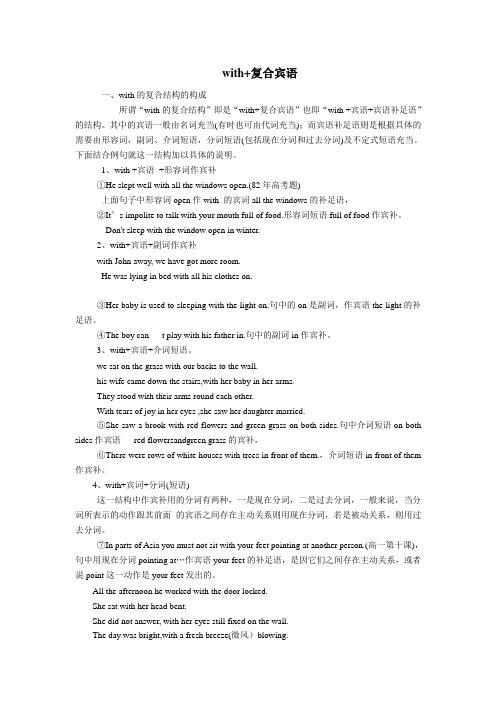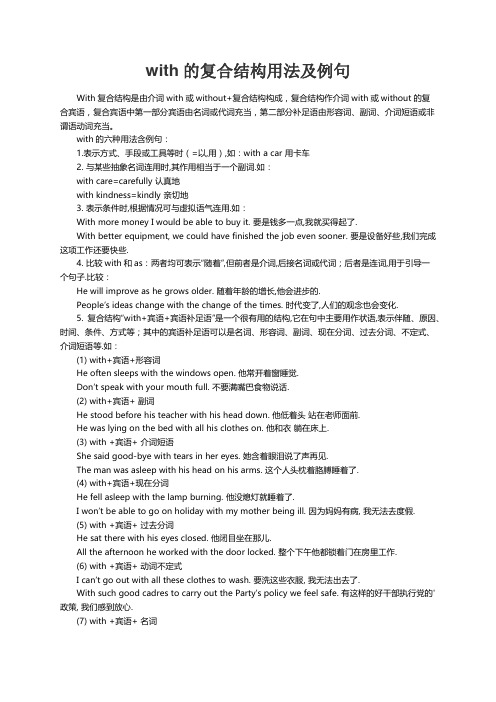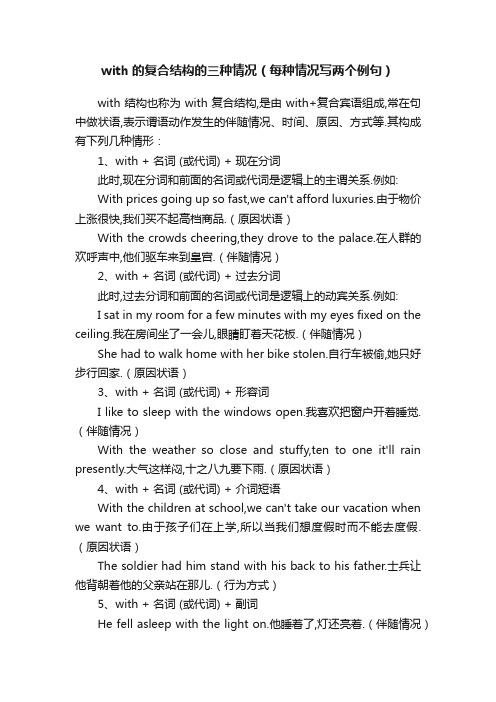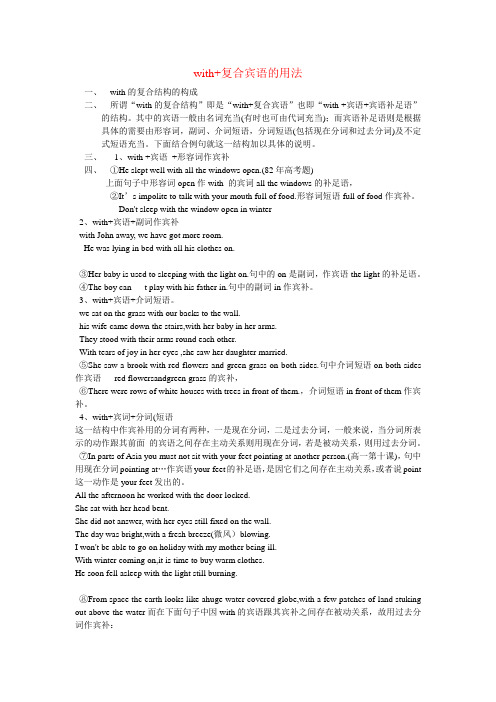with复合宾语的用法(20201118215048)
语法之with+复合宾语

with+复合宾语一、with的复合结构的构成所谓“with的复合结构”即是“with+复合宾语”也即“with +宾语+宾语补足语”的结构。
其中的宾语一般由名词充当(有时也可由代词充当);而宾语补足语则是根据具体的需要由形容词,副词、介词短语,分词短语(包括现在分词和过去分词)及不定式短语充当。
下面结合例句就这一结构加以具体的说明。
1、with +宾语+形容词作宾补①He slept well with all the windows open.(82年高考题)上面句子中形容词open作with 的宾词all the windows的补足语,②It’s impolite to talk with your mouth full of food.形容词短语full of food作宾补。
Don't sleep with the window open in winter.2、with+宾语+副词作宾补with John away, we have got more room.He was lying in bed with all his clothes on.③Her baby is used to sleeping with the light on.句中的on是副词,作宾语the light的补足语。
④The boy can t play with his father in.句中的副词in作宾补。
3、with+宾语+介词短语。
we sat on the grass with our backs to the wall.his wife came down the stairs,with her baby in her arms.They stood with their arms round each other.With tears of joy in her eyes ,she saw her daughter married.⑤She saw a brook with red flowers and green grass on both sides.句中介词短语on both sides作宾语red flowersandgreen grass的宾补,⑥There were rows of white houses with trees in front of them.,介词短语in front of them 作宾补。
with的复合结构用法及例句

with的复合结构用法及例句With复合结构是由介词with或without+复合结构构成,复合结构作介词with或without的复合宾语,复合宾语中第一部分宾语由名词或代词充当,第二部分补足语由形容词、副词、介词短语或非谓语动词充当。
with的六种用法含例句:1.表示方式、手段或工具等时(=以,用),如:with a car 用卡车2. 与某些抽象名词连用时,其作用相当于一个副词.如:with care=carefully 认真地with kindness=kindly 亲切地3. 表示条件时,根据情况可与虚拟语气连用.如:With more money I would be able to buy it. 要是钱多一点,我就买得起了.With better equipment, we could have finished the job even sooner. 要是设备好些,我们完成这项工作还要快些.4. 比较with和as:两者均可表示“随着”,但前者是介词,后接名词或代词;后者是连词,用于引导一个句子.比较:He will improve as he grows older. 随着年龄的增长,他会进步的.People’s ideas change with the change of the times. 时代变了,人们的观念也会变化.5. 复合结构“with+宾语+宾语补足语”是一个很有用的结构,它在句中主要用作状语,表示伴随、原因、时间、条件、方式等;其中的宾语补足语可以是名词、形容词、副词、现在分词、过去分词、不定式、介词短语等.如:(1) with+宾语+形容词He often sleeps with the windows open. 他常开着窗睡觉.Don’t speak with your mouth full. 不要满嘴巴食物说话.(2) with+宾语+ 副词He stood before his teacher with his head down. 他低着头站在老师面前.He was lying on the bed with all his clothes on. 他和衣躺在床上.(3) with +宾语+ 介词短语She said good-bye with tears in her eyes. 她含着眼泪说了声再见.The man was asleep with his head on his arms. 这个人头枕着胳膊睡着了.(4) with+宾语+现在分词He fell asleep with the lamp burning. 他没熄灯就睡着了.I won’t be able to go on holiday with my mother being ill. 因为妈妈有病, 我无法去度假.(5) with +宾语+ 过去分词He sat there with his eyes closed. 他闭目坐在那儿.All the afternoon he worked with the door locked. 整个下午他都锁着门在房里工作.(6) with +宾语+ 动词不定式I can’t go out with all these clothes to wash. 要洗这些衣服, 我无法出去了.With such good cadres to carry out the Party’s policy we feel safe. 有这样的好干部执行党的'政策, 我们感到放心.(7) with +宾语+ 名词He died with his daughter yet a schoolgirl. 他去世时,女儿还是个小学生.With复合结构:一、with或without+名词/代词+形容词例句:1.I like to sleep with the windows open.我喜欢把窗户开着睡觉。
with的复合结构的三种情况(每种情况写两个例句)

with的复合结构的三种情况(每种情况写两个例句)with结构也称为with复合结构,是由with+复合宾语组成,常在句中做状语,表示谓语动作发生的伴随情况、时间、原因、方式等.其构成有下列几种情形:1、with + 名词 (或代词) + 现在分词此时,现在分词和前面的名词或代词是逻辑上的主谓关系.例如:With prices going up so fast,we can't afford luxuries.由于物价上涨很快,我们买不起高档商品.(原因状语)With the crowds cheering,they drove to the palace.在人群的欢呼声中,他们驱车来到皇宫.(伴随情况)2、with + 名词 (或代词) + 过去分词此时,过去分词和前面的名词或代词是逻辑上的动宾关系.例如:I sat in my room for a few minutes with my eyes fixed on the ceiling.我在房间坐了一会儿,眼睛盯着天花板.(伴随情况)She had to walk home with her bike stolen.自行车被偷,她只好步行回家.(原因状语)3、with + 名词 (或代词) + 形容词I like to sleep with the windows open.我喜欢把窗户开着睡觉.(伴随情况)With the weather so close and stuffy,ten to one it'll rain presently.大气这样闷,十之八九要下雨.(原因状语)4、with + 名词 (或代词) + 介词短语With the children at school,we can't take our vacation when we want to.由于孩子们在上学,所以当我们想度假时而不能去度假.(原因状语)The soldier had him stand with his back to his father.士兵让他背朝着他的父亲站在那儿.(行为方式)5、with + 名词 (或代词) + 副词He fell asleep with the light on.他睡着了,灯还亮着.(伴随情况)The boy stood there with his head down.这个男孩低头站在那儿.(伴随情况)6 、with + 名词 (或代词) + 动词不定式此时,不定式表示将发生的动作.例如:With no one to talk to,John felt miserable.由于没人可以说话的人,约翰感到很悲哀.(原因状语)With a lot of work to do,he wasn't allowed to go out.因为还有很多工作要做,他没有被允许外出.(原因状语)。
with复合宾语句型

with复合宾语句型with复合宾语复合宾语with宾语宾补宾语从句的复合句双宾语和复合宾语复合宾语结构宾语从句复合句宾语复合句宾语从句改复合句
with复合宾语句型
(1) with + n + adj. He stared at me with his mouth open. 他张着嘴凝视着我。 (2) with + n + adv The boy stood there, with his head down. 这男孩低着头站在 那。 (3) with + n + 介词短语 He stood with his hand in his pocket. 他站着,一手插在衣袋 里。 (4) with + n + 动词不定式 With no one to talk to, John felt miserable. 由于没有可谈话的人,John觉得很悲伤。 (5) with + n + 现在分词 With prices going up so fast, we can't afford luxuries. 由于物价迅猛上涨,我们买不起高当商品。 (6) with + n + 过去分词 With her eyes fixed on the opposite wall, she did not answer immediately. 她的眼睛盯着对面的墙壁,她没有立即回答。
with的复合结构的用法

with宾语宾语补足语此结构在句中常作状语可位于句首或句尾常作时间原因方式伴随状语亦可作后置定语
with复合结构
一、with复合结构: “with+宾语+宾语补足语” 此结构在句中常作状语,可位于句首或句尾, 常作时间、原因、方式、伴随状语,亦可作后置 定语。 二、 with复合结构的构成 1. with+宾语+adj.(adj.表状态) He used to sleep with all the windows open. 他过去常常开着窗子睡觉。 She lay in bed with her face pale. 她躺在床上,脸色苍白。
6. She was left alone, with________to look after her. A. someone B. anyone C. no one D. many people 7.________his leg broken, he couldn't come to school as usual. A. Because B. Because of C. With D. For 8. Work starts every day at 7:00 a.m. and goes on until late afternoon________a break at midday. A. by B. with C. for D. after
4. with+宾语+ 介词短语 The teacher came in with a book in his hand. 老师进来了,手里拿着本书。 5. with+宾语+doing (doing表主动或正在进行) With the machine helping us, we could finish the work on time. 由于有机器的帮助,我们能按时完成任务。
高中with的复合结构用法

高中with的复合结构用法介词with在英语中非常常见,它可以表示具有、和、用、以、跟、同、带有、使用等多种含义。
除了作为介词后面跟名词或代词作宾语外,with还可以构成复合结构,即with+宾语+宾语补足语。
这种复合结构在句中可以作状语或定语,表示伴随、原因、条件、方式等意义。
宾语补足语可以是形容词、副词、名词、介词短语、现在分词、过去分词或不定式等。
下面我们来具体看看with的复合结构的用法和例句。
1.with+宾语+形容词这种结构表示宾语的特征或状态,常用来作状语或定语。
例句:•He likes to sleep with the window open. 他喜欢开着窗户睡觉。
•She entered the room with her face red with cold. 她脸上冻得通红地走进房间。
•The boy was sitting on the ground with his eyes closed. 男孩闭着眼睛坐在地上。
•With water plentiful, the lawns were green all summer. 因为水很充足,整个夏天草坪都很绿。
•The girl was wearing a dress with flowers printed on it. 女孩穿着一件印有花朵图案的裙子。
2.with+宾语+副词这种结构表示宾语所处的位置或状态,常用来作状语。
例句:•With John away, we’ve got more rooms. 随着约翰离开,我们有了更多房间。
•He stood there with his back to me. 他背对着我站在那里。
•She walked out of the room with a smile on her face. 她面带微笑地走出房间。
•He left the house with nothing said. 他什么也没说就离开了房子。
with复合结构用法归纳

with复合结构用法归纳With 复合结构指的是“with+宾语+宾语补足语”结构,它是一个十分有用的结构,不仅教材中经常出现,考试中经常考到,而且它也是同学们写作时使句子变得“高级”的一个重要手段。
学会正确运用它,你会多方面受益。
with复合结构形式一:with+宾语+形容词He often sleeps with the windows open. 他常开着窗睡觉。
Don’t speak with your mouth full. 不要满嘴巴食物说话。
with复合结构形式二:with+宾语+副词He stood before his teacher with his head down. 他低着头站在老师面前。
He was lying on the bed with all his clothes on. 他和衣躺在床上。
with复合结构形式三:with+宾语+名词He died with his daughter yet a schoolgirl. 他去世时,女儿还是个小学生。
with复合结构形式四:with+宾语+介词短语She said good-bye with tears in her eyes. 她含着眼泪说了声再见。
He was asleep with his head on his arms. 他头枕着胳膊睡着了。
with复合结构形式五:with+宾语+现在分词(短语)He fell asleep with the lamp burning. 他没熄灯就睡着了。
I won’t be able to go on holiday with my mother being ill. 因为妈妈有病,我无法去度假。
with复合结构形式六:with+宾语+过去分词(短语)He sat there with his eyes closed. 他闭目坐在那儿。
All the afternoon he worked with the door locked. 整个下午他都锁着门在房里工作。
with复合宾语的用法

with+复合宾语的用法一、with的复合结构的构成二、所谓“with的复合结构”即是“with+复合宾语”也即“with +宾语+宾语补足语”的结构。
其中的宾语一般由名词充当(有时也可由代词充当);而宾语补足语则是根据具体的需要由形容词,副词、介词短语,分词短语(包括现在分词和过去分词)及不定式短语充当。
下面结合例句就这一结构加以具体的说明。
三、1、with +宾语+形容词作宾补四、①He slept well with all the windows open.(82年高考题)上面句子中形容词open作with 的宾词all the windows的补足语,②It’s impolite to talk with your mouth full of food.形容词短语full of food作宾补。
Don't sleep with the window open in winter2、with+宾语+副词作宾补with John away, we have got more room.He was lying in bed with all his clothes on.③Her baby is used to sleeping with the light on.句中的on是副词,作宾语the light的补足语。
④The boy can t play with his father in.句中的副词in作宾补。
3、with+宾语+介词短语。
we sat on the grass with our backs to the wall.his wife came down the stairs,with her baby in her arms.They stood with their arms round each other.With tears of joy in her eyes ,she saw her daughter married.⑤She saw a brook with red flowers and green grass on both sides.句中介词短语on both sides 作宾语red flowersandgreen grass的宾补,⑥There were rows of white houses with trees in front of them.,介词短语in front of them作宾补。
- 1、下载文档前请自行甄别文档内容的完整性,平台不提供额外的编辑、内容补充、找答案等附加服务。
- 2、"仅部分预览"的文档,不可在线预览部分如存在完整性等问题,可反馈申请退款(可完整预览的文档不适用该条件!)。
- 3、如文档侵犯您的权益,请联系客服反馈,我们会尽快为您处理(人工客服工作时间:9:00-18:30)。
with+复合宾语的用法一、with的复合结构的构成二、所谓"with的复合结构”即是"with+复合宾语”也即"with +宾语+宾语补足语”的结构。
其中的宾语一般由名词充当(有时也可由代词充当);而宾语补足语则是根据具体的需要由形容词,副词、介词短语,分词短语(包括现在分词和过去分词)及不定式短语充当。
下面结合例句就这一结构加以具体的说明。
三、1、with +宾语+形容词作宾补四、①He slept well with all the windows open.(82 年高考题)上面句子中形容词open作with的宾词all the windows的补足语,②It' s impolite to talk with your mouth full of food. 形容词短语full of food 作宾补。
Don'tsleep with the window ope n in win ter2、with+宾语+副词作宾补with Joh n away, we have got more room.He was lying in bed with all his clothes on.③Her baby is used to sleeping with the light on.句中的on 是副词,作宾语the light 的补足语。
④The boy can t play with his father in.句中的副词in 作宾补。
3、with+宾语+介词短语。
we sat on the grass with our backs to the wall.his wife came dow n the stairs,with her baby in her arms.They stood with their arms round each other.With tears of joy in her eyes ,she saw her daughter married.⑤She saw a brook with red flowers and green grass on both sides. 句中介词短语on both sides 作宾语red flowersandgreen grass 的宾补,⑥There were rows of white houses with trees in front of them.,介词短语in front of them 作宾补。
4、with+宾词+分词(短语这一结构中作宾补用的分词有两种,一是现在分词,二是过去分词,一般来说,当分词所表示的动作跟其前面的宾语之间存在主动关系则用现在分词,若是被动关系,则用过去分词。
⑦In parts of Asia you must not sit with your feet pointing at another person.(高一第十课),句中用现在分词pointing at…作宾语your feet的补足语,是因它们之间存在主动关系,或者说point 这一动作是your feet发出的。
All the after noon he worked with the door locked.She sat with her head bent.She did not an swer, with her eyes still fixed on the wall.The day was bright,with a fresh breeze(微风)blowing.I won't be able to go on holiday with my mother being ill.With win ter coming on ,it is time to buy warm clothes.He soon fell asleep with the light still bur ning.⑧From space the earth looks like ahuge water covered globe,with a few patches of land stuk ing out above the water而在下面句子中因with的宾语跟其宾补之间存在被动关系,故用过去分词作宾补:⑨The murderer was brought in ,with his hands tied back.(91 年高考题)。
但当with 的复合结构中语是表示人体部位名称的名词时,作宾补用的分词是现在分词是过去分词,则应视这一动词而定。
一般来说,若此动词是及物动词则用其过去分词形式,若是不及物动词,则用其现在分词形式。
⑩ An old man was lying there with his eyes shut. 此句中shut 是及物动词,故用其过去分词He lay on his back with his eyes looking straight up wards.look 为不及物动词,故用现在分词。
5、with+ 宾语+不定式短语。
I can't go out with you, with much homework to be done. 句中的宾补由to be done 这一不定式的被动结构充当,表示do 这一动作的将来含义或未完成之意,用其被动态则说明其与宾语之间存在被动关系。
With five minutes to go before the last train left,we arrived.I can't go out with all these dishes to wash.So in the afternoon, with nothing to do, I went around the school.With such an experienced teacher to teach us English,we are very happy.6, with+ 宾语+名词He died in the battle with his son only a ten-month-old baby.二、with 的复合结构的用法1,在句子中with 结构多数充当状语,表示行为方式,伴随情况、时间、原因或条件She came into the room ,with her nose red because of cold.(with+ 名词+形容词,作伴随状语)With the meal over ,we all went home. (with+ 名词+ 副词,作时间状语)The master was walking up and down with the ruler under his arm。
(with+ 名词+ 介词短语,作伴随状语。
)The teacher entered the classroom with a book in his hand.He lay in the dark empty house ,with not a man ,woman or child to say he was kind to me.(with+ 名词+不定式,作伴随状语)He could finish it with me to help him. (with+ 代词+不定式,作条件状语)She fell asleep with the light burning. (with+ 名词+现在分词,作伴随状语)With nothing left in the cupboard ,she went out to get something to eat. (with+ 代词+过去分词,作为原因状语)2,With 结构在句中也可以作定语。
例如:From space the earth looks like a huge water-covered globe with a few patches of land sticking out above the water.A little boy with two of his front teeth missing ran into the house.Do you know the woman with a gold necklace around her neck?三,几点说明。
1,without + 宾语+宾语补足语是with +宾语+宾语补足语结构的另一表现形式。
He could not finish it without me to help him. (without+ 代词+不定式,作条件状语)Without anything left in the cupboard ,she went out to get something to eat. (without+ 代词+过去分词,作为原因状语)Possibly this person died without anyone knowing where the coins were hidden.(高二22 课)(without+ 代词+现在分词,作为伴随状语)Without anyone noticing ,I slipped out of the room. (without+ 代词+现在分词,作为伴随状语)Without a word more spoken ,he went back home2, with 的复合结构与独立主格结构的关系:把with 的复合结构中的介词with 去掉,即构成独立主格结构。
其结构为名词(代词)+ 现在分词、过去分词;例如;The test finished, we began our holiday. = When the test was finished, we began our holiday. 考试结束了,我们开始放假。
The president assassinated, the whole country was in deep sorrow.= After the president was assassinated, the whole country was in deep sorrow. 总统被谋杀了,举国上下沉浸在悲哀之中。
Weather permitting, we are going to visit you tomorrow.=If weather permits,we are going to visit you tomorrow. 天气允许,我们明天去看你。
